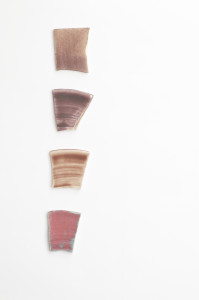
I have recently finished teaching my glaze courses at West Dean and Morley College. Several students were interested in barium matt glazes. As barium carbonate is a toxic material, many colleges have changed to using strontium carbonate. While strontium carbonate is not toxic, it still may contain a small amount of barium carbonate, so care should still be taken when using it.
Barium matts give a range of bright colours: turquoise from copper, chartreuse from chromium, bright blue from cobalt, pink from manganese and purple or bright pink from nickel oxide. Strontium gives similar effects, although it sits between barium and calcium in the periodic table.
To substitute strontium for barium in a glaze recipe, you should multiply by 0.75. Strontium is lighter than barium, so less is needed to give the same number of molecules in a glaze. The recipe can then be re-calculated to add up to 100.
The following is a cone 8 (1250 C) barium matt recipe from my book the Handbook of Glaze recipes which I have converted to strontium.
Potash feldspar 40
Strontium carbonate 30
Lithium carbonate 3
China clay 6
Flint 18
Zinc oxide 3
The glaze gives a good turquoise with the addition 2% copper oxide.


